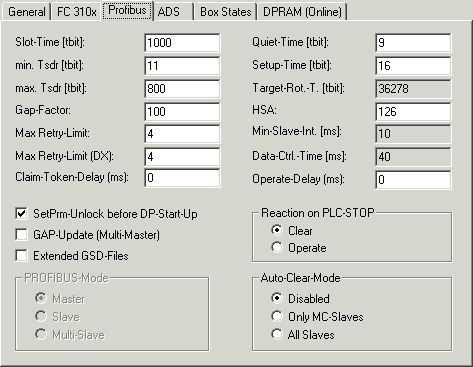Profibus tab
Slot-Time: The Slot-Time indicates how long the DP master will wait for a response from the DP slave before it sends either a repetition or the next telegram.
min. Tsdr: The min. Tsdr indicates the minimum length of time for which the DP slave will wait with a response. This time is set for all the DP slaves during the DP start-up (the value range is 11-255 bit periods). The min. Tsdr must be smaller than the max. Tsdr.
max. Tsdr: The max. Tsdr indicates the maximum length of time for which the DP slave may wait with a response. This time is set according to the DP slave's GSD file entries. The max. Tsdr must be smaller than the slot time.
Max-Retry-Limit: The Max-Retry-Limit specifies how often a telegram should be repeated, if the device addressed does not answer. The minimum value should be 1, so that, in case of an error, there will be at least one repeat for acyclic telegrams (see the Error Reactions chapter).
Max-Retry-Limit (DX): Since the Data_Exchange telegram is repeated cyclically, a value of 0 could be used for the repetition of the Data_Exchange telegram here, in order to keep the cycle relatively constant in equidistant mode, even if there is no response from a device. However, in this case it would make sense to set the Features tab for the box such that lack of response of the slave would not lead to DATA EXCH being exited. The fact that a device has not responded is apparent from DpState, which would not be equal 0 for one cycle (see the Error Reactions chapter).
GAP Update: The GAP update asks all stations up to HSA at intervals to confirm their presence. It can be en/disabled. The GAP update is relevant only for multi-master operation. In single master operation it increases PROFIBUS cycle jitter and is therefore switched off by default.
GAP-Factor: The GAP factor determines how often the GAP update will be carried out (assuming it is activated). The time between two GAP updates cycles is Gap-Factor * Target-Rot.-T.
HSA: The HSA specifies the highest active address up to which the GAP update is carried out (assuming it is active).
Min. Slave-Int.: The MinSlaveInterval indicates the minimum cycle time with which the DP StartUp telegrams are sent the DP slaves (it is determined from the settings found in the GSD file).
PROFIBUS Mode: This is where the selection is made between master functionality (the default setting) and slave functionality.
Auto-Clear-Mode: It is possible to specify here whether the master enters (or stays in) the "Clear" state as long as either at least one MC slave (the "Only MC-Slaves" setting) or any slave (the "All Slaves" setting) does not respond correctly (has a DpState other than 0) (see the Error Reactions chapter).
Clear-Delay: The DP master changes automatically into the clear mode (the outputs of the slaves are set either to 0 or to the fail-safe values) when it ceases to receive an interrupt from the associated task (e.g. a PLC breakpoint has been reached, or the system has crashed). It is possible to specify here how many missing tasks cycles can be tolerated before the master switches into the clear mode. This setting is independent of the setting in the Auto-Clear-Mode.
Operate-Delay: The DP master changes automatically, observing the Auto-Clear-Mode, into the operate state when the task is started. The transition from Clear to Operate can be delayed with the Operate delay time. In the Clear state, all the outputs are set to 0 (if the DP slave does not support Fail_Safe values) or to the Fail_Safe value (if the DP slave supports Fail_Safe), whereas in the Operate state the outputs have the values specified by the task.
Reaction on PLC-STOP: It is possible to specify here whether the DP master should set the outputs to 0 when reaching a PLC stop or breakpoint, or should leave them unchanged (see the Fault Reactions chapter).
Redundancy-Mode: Redundancy mode can be set here for the DP master. In that case all that it does is to listen to the bus (see the Master Redundancy chapter).
SetPrm-Unlock before DP-Start-Up: Normally, during DP start-up, the DP master removes the cyclic connections, so that the DP slave can always recognize that the DP master has restarted. In redundancy mode, however, it may be specifically desirable for the DP slave to remain unaware of this, because the switch-over from the primary master to the redundant master should not have any interactions for the DP slave (see the Master Redundancy chapter).
SetPrm-Unlock at DP-Shutdown: Normally, during DP shut-down, the DP master removes the cyclic connections, so that the DP slave can always recognize that the DP master has stopped. In redundancy mode, however, it may be specifically desirable for the DP slave to remain unaware of this, because the switch-over from the primary master to the redundant master should not have any interactions for the DP slave (see the Master Redundancy chapter).
